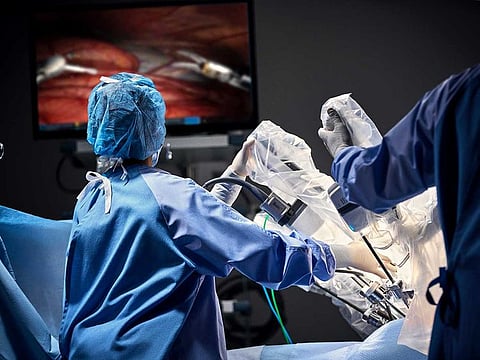Rise of the robo-docs
Why are UAE hospitals acquiring robotic platforms despite high costs?

“Look here – as you can see, there’s barely any scarring.” Dr Hatem Moussa, an expert in robotic-assisted laparoscopic surgeries, is pointing at the torso of his patient, Nazeeh A., 48, who recently underwent a low rectal cancer procedure. Indeed, the only visible signs are a pair of dark circles on either side of Nazeeh’s belly – they could be birthmarks. “I was able to walk the same day of the surgery, eat the day after and was cleared to return to work within a week,” he tells GN Focus.
With his passion for the potential of robotic surgery, Dr Moussa, Director of General and Oncological Surgery at American Hospital Dubai, straddles the line between practitioner and evangelist. “If a patient like Nazeeh underwent a conventional open surgery to remove the cancerous specimen, he would have needed to stay in the hospital for two to three weeks after the procedure. He’d spend a few days in ICU, require blood transfusions, antibiotics and heavy pain medication, all the while running a risk of infection or a hernia from the large incision.”
Dr Moussa used the da Vinci Xi to carry out this procedure, and he’s not the only UAE-based surgeon to sing its praises.
Dr Roger Gerjy, Consultant General and Colorectal Surgeon at Mediclinic City Hospital, is eager to explain its parts: the patient cart, surgeon console and vision tower. “Aside from that there is a range of different instruments we can use to perform operations, all from different setups of graspers, energy devices and staplers.” The surgeon sits comfortably in the console and performs the operation without getting fatigue or shoulder pain, says Dr Gerjy, which may occur after a conventional laparoscopic procedure.
“The main difference with the robotic instruments compared with conventional laparoscopic instruments is that they are articulated – we have the same range of motion as our wrists inside the body with this tine (1-2cm instruments) and a high-definition 3D view with up to ten times enlargement. With those features the operation can be performed causing minimal trauma to the tissue during the procedure, which will result in all the postoperative benefits for the patients.”
Common procedures
At Cleveland Clinic Abu Dhabi, the most common types of robotic surgery performed are cardiac procedures, digestive diseases, and urological and gynaecological procedures. “We have previously performed the first robotic resection of a pelvic tumour, robotic gastrectomy for removal of stomach tumour and robotic liver resections,” says Dr Kashif Siddiqi, Staff Physician at the Surgical Subspecialties Institute, Cleveland Clinic Abu Dhabi. However, Dr Siddiqi also points out that not every patient is an ideal candidate for a robotic procedure. “A multidisciplinary team at Cleveland Clinic Abu Dhabi collaborates to review each case to determine the right course of action.”
Dr Moussa lists hysterectomy, abdominal wall hernia repair and nephrectomy as the three most common procedures carried out with robots at his hospital, while Dr Gerjy singles out hernia surgeries, gallbladder surgeries and colon resection in that order. Mediclinic City Hospital aims to perform the majority of colorectal cancer and complex ventral hernia procedures with robots, he adds.
Despite the da Vinci device’s steep cost – reportedly about $2 million (Dh7.34 million) – Dr Moussa is keen to stress the economic benefits for patients. “Look at the financial impact of a conventional open surgery. For companies, families, the patient – no one can afford a person being out of work for two or three months. There’s also the costs of pain medication, antibiotics, an ICU stay, blood transfusions to think about, as well as a risk of infection or hernia resulting from the large incision.”
Patient experiences
Several UAE-based patients shared their experience of robotic surgeries in the country. M.S.V., a 55-year-old patient who underwent a robotic whipple surgery that involved the pancreas at Cleveland Clinic Abu Dhabi, initially harboured some reservations about the idea of a robotic procedure, but her doctor set her mind at ease. “He was very transparent and explained all the benefits and possible complications, which helped instil the confidence I needed to go ahead. I think it is very important to build that rapport and trust with your doctors.
Madelene Lundholm, a Mediclinic patient, had an unpleasant previous experience of conventional surgery. “I was hospitalised for three weeks and went through some really hard times. So when I was told that I had developed a hernia and that I would possibly have to go through another open gut surgery to fix it – that is something that I didn’t want to do. I didn’t want to go through that trauma again. So I looked everywhere to find a more appropriate procedure for me. I came upon Dr Gerjy and his robotic technique and I thought that this was perhaps for me. Thanks to the new technique, I had a much better and shorter recovery. I was able to leave the hospital after two nights and I could go back to my normal routines quicker.”
The cost of a robotic procedure varies, as does insurance coverage. While Dr Gerjy says laparoscopic surgeries are covered by most insurances at Mediclinic City Hospital, he hopes insurers will study the patient benefits and cover robotic procedures in the future. Dr Moussa says insurance doesn't cover robotic surgeries at American Hospital Dubai, though he too hopes that may change in the near future. “The hospital is negotiating with the insurance companies at this time.”
Sign up for the Daily Briefing
Get the latest news and updates straight to your inbox



